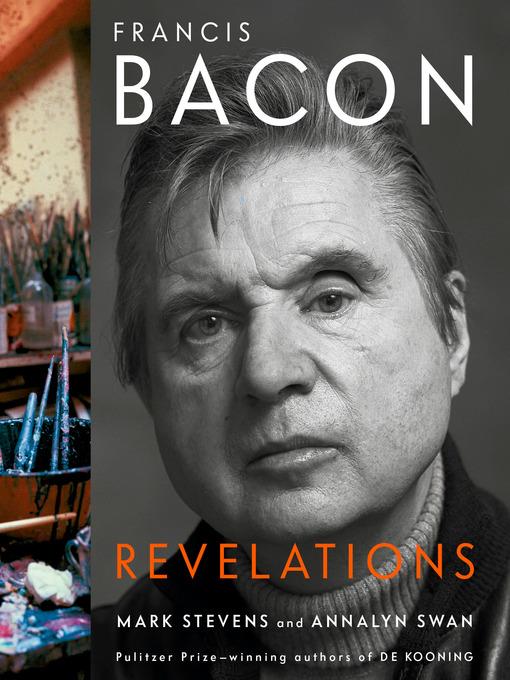
Francis Bacon
Revelations
- اطلاعات
- نقد و بررسی
- دیدگاه کاربران
نقد و بررسی

June 1, 2020
Stevens, a former art critic of New York magazine, and Swan, a former arts editor of Newsweek who teaches biography at CUNY's Graduate Center, won the 2005 Pulitzer Prize for de Kooning: An American Master. Here, in nearly 1,000 pages, they explore in-depth the life and work of powerhouse artist Francis Bacon, whose disturbing images have shaped contemporary iconography.
Copyright 2020 Library Journal, LLC Used with permission.

December 15, 2020
An appropriately hefty biography of the mercurial artist. In this exhaustively researched, well-rounded profile, which took a decade to complete, Stevens and Swan, the Pulitzer-winning authors of de Kooning: An American Master (2004), make one of the few attempts to give a holistic account of the iconic Bacon (1909-1992). While the artist's friend Michael Peppiatt offered an intimate first-person account in Francis Bacon in Your Blood (2015), this is a forensic, sweeping text from two acclaimed art critics, based on hundreds of interviews. The authors skimp neither on context nor on details regarding Bacon's friends and lovers, and they are unafraid to dig into the more volatile elements of his character. Lucian Freud, note the authors, "called him the most fearless man he had ever met." Presented in a linear fashion, the narrative lends a picaresque feel to Bacon's sometimes tragic, often dandyish life. While his habit of wandering among the pubs of London's Soho is well known, many readers will be particularly enlightened by the chapters about his childhood among the Anglo-Irish gentry, born an outsider in a house dominated by a chauvinistic father during the eruption of the Troubles. The book, featuring photos throughout, also functions as a dynamic depiction of life as a gay man in Europe during the 20th century, constantly reminding readers of the specter of violence that haunted the LGBTQ+ community for decades. Furthermore, the authors' analyses of individual paintings, mostly free of unnecessarily technical language, are insightful. "Like Aeschylus," they write, "Bacon hoped to capture the inexpressible" and "reach some deeper, more visceral nerve." Resisting attempts at biography, Bacon once "remarked that it would take a Proust" to do him justice. Hyperbole, to be sure, but Stevens and Swan are up to the task of demonstrating the many complexities of an intense, significant artistic life. An unflinching portrayal of an often unwieldy character--further proof of Bacon's enduring influence.
COPYRIGHT(2020) Kirkus Reviews, ALL RIGHTS RESERVED.

March 1, 2021
Stevens and Swan, authors of the Pulitzer Prize-winning de Kooning (2004) pay homage to the contentious man and artist Francis Bacon in this authoritative and immersive account. Born in 1909 to a distinguished Australian English family, Bacon was afflicted in childhood by asthma and anxiety disorders, prompting his father's detachment and Bacon's great disdain for the trappings of aristocratic life. He dabbled in the decorative arts before painting beckoned him. Lacking formal training but possessing a deep well of inspiration gleaned from his reading and travels, Bacon set out to express the psychological torment that encapsulated his life. Bacon's fixation on crucifixion, popes, and distorted human forms, and his unique approach to rendering them, were influenced by Vel�zquez, Picasso, and Van Gogh. Bacon could be both sheepish and flamboyant about his sexuality. Given the social repressions of the time, he knew when and where to reveal his homosexuality. He had his share of sexual escapades, and two great loves, each a passionate and violent relationship that ended in tragedy. Bacon's interior and exterior worlds, fraught with frailties and self-destruction, led him to create his most startling work. It is Bacon's complexity and daring that Stevens and Swan illuminate so precisely in this surpassingly literary biography.
COPYRIGHT(2021) Booklist, ALL RIGHTS RESERVED.

Starred review from April 19, 2021
In this monumental work, Pulitzer Prize–winning art critics Stevens and Swan (De Kooning: An American Master) make a convincing case that “the twentieth century does not know itself without” the work of English painter Francis Bacon (1909–1992). Starting with Bacon’s birth and fraught childhood in Ireland, the authors trace his exploration of cubism, surrealism, and expressionism on his way to emerging as a major figure on the international art scene near the end of WWII, a lofty position that has only increased since his death. Throughout, Swan and Stevens provide penetrating insights into his complex psyche, his sexuality (Bacon was gay), his friendships, and how such a “handsome, witty, and amiable” person could have created paintings that many see as grotesque and even nightmarish. While his contemporaries, such as Henry Moore, created art that “sensitively expressed ‘the terrible toll of war,’ ” Bacon shocked audiences by “mercilessly attacking every comforting platitude of the twentieth century” and exposing the hypocrisy of postwar London society. Often mocking religious iconography with distorted figures and tormented ghouls, he captured the “living tension between power and powerlessness.” Full of illuminating details and written in exquisite prose, this a fascinating look at the dichotomy between an artist’s inner life and their work.




دیدگاه کاربران